The Development of Social Bonds
As you see, the social context has a powerful impact on development. So does the infant’s age, via brain maturation. With regard to emotional development, the age of the baby determines specific social interactions that lead to growth—
Synchrony
Early parent–
Both Partners Active
Detailed research reveals the symbiosis of adult–
Direct observation reveals synchrony; anyone can see it when watching a caregiver play with an infant who is too young to talk. It is also evident in computer measurement of the millisecond timing of smiles, arched eyebrows, and so on (Messinger et al., 2010). Synchrony is a powerful learning experience for the new human. In every interaction, infants read others’ emotions and develop social skills, such as taking turns and watching expressions.
Synchrony usually begins with adults imitating infants (not vice versa), with tone and rhythm (Van Puyvelde et al., 2010). Adults respond to barely perceptible infant facial expressions and body motions. This helps infants connect their internal state with behaviors that are understood within their culture. Synchrony is particularly apparent in Asian cultures, perhaps because of a cultural focus on interpersonal sensitivity (Morelli & Rothbaum, 2007).

In Western cultures as well, parents and infants become partners. This relationship is crucial when the infant is at medical risk. The necessity of time-
Neglected Synchrony
Is synchrony necessary? If no one plays with an infant, what will happen? Experiments involving the still-
In still-
To be specific, long before they can reach out and grab, infants respond excitedly to caregiver attention by waving their arms. They are delighted if the adult moves closer so that a waving arm can touch the face or, even better, a hand can grab hair. You read about this eagerness for interaction (when infants try to “make interesting events last”) in Chapter 6.
In response, adults open their eyes wide, raise their eyebrows, smack their lips, and emit nonsense sounds. Hair-
In still-
Many studies of still faces and other reactions reach the same conclusion: Babies need synchrony. Responsiveness aids psychosocial and biological development, evident in heart rate, weight gain, and brain maturation. Particularly in the first year, depressed and anxious mothers are less likely to respond with synchrony to their infants, and then babies become less able to respond to social cues (Atzil et al., 2014).
Attachment
Toward the end of the first year, face-
Instead attachment becomes evident. Actually, attachment is lifelong, beginning before birth and influencing relationships throughout life (see At About This Time). Thousands of researchers on every continent have studied attachment.
Researchers were inspired by John Bowlby (1982, 1983) and by Mary Ainsworth, who described mother–
Signs of Attachment
Infants show their attachment through proximity-
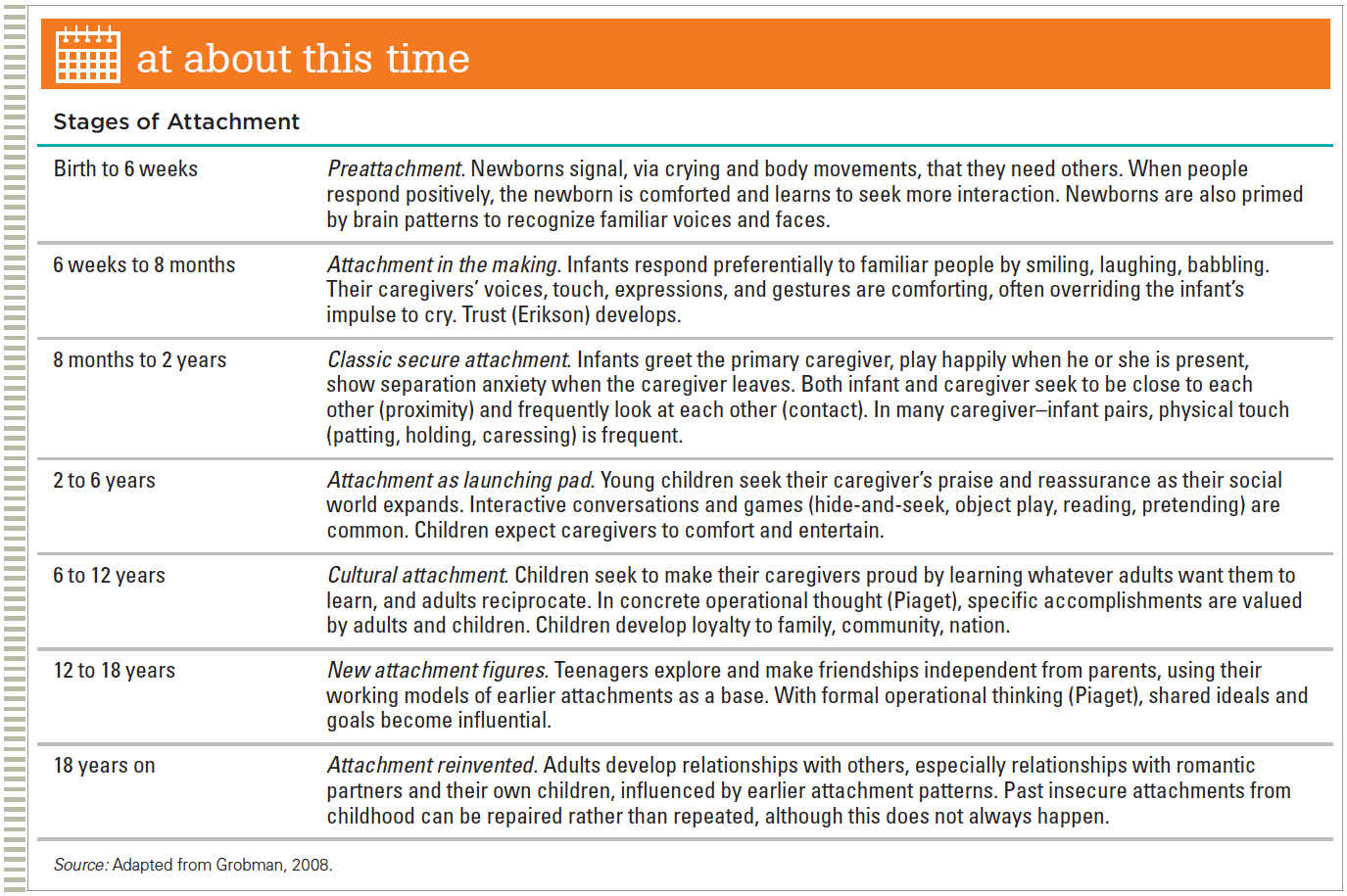
VISUALIZING DEVELOPMENT
Developing Attachment
Attachment begins at birth and continues lifelong. Much depends not only on the ways in which parents and babies bond, but also on the quality and consistency of caregiving, the safety and security of the home environment, and individual and family experience. While the patterns set in infancy may echo in later life, they are not determinative.
HOW MANY CHILDREN ARE SECURELY ATTACHED?
The specific percentages of children who are secure and insecure vary by culture, parent responsiveness, and specific temperament and needs of both the child and the caregiver. Generally, about a third of all 1-
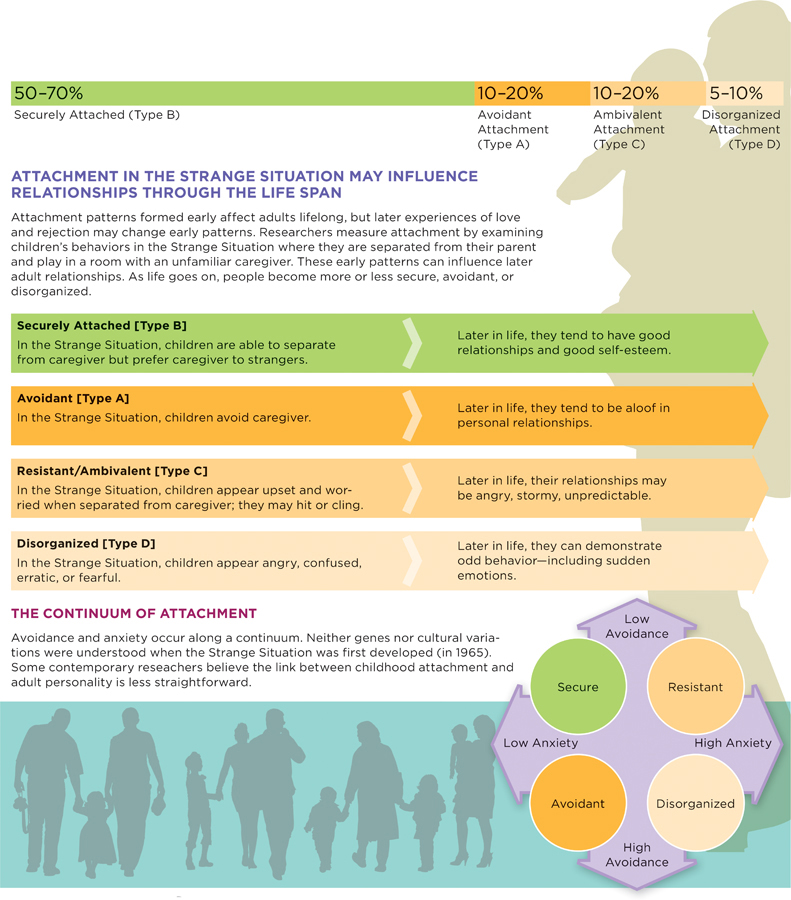

Video Activity: Mother Love and the Work of Harry Harlow features classic footage of Harlow’s research, showing the setup and results of his famous experiment.
To maintain contact when driving in a car and to reassure the baby, some caregivers in the front seat reach back to give a hand, or install a mirror so they can see the baby and the baby can see them as they drive. Some caregivers take the baby into the bathroom, leading to one’s mother’s complaint that she hadn’t been alone in the bathroom for two years (Senior, 2014). As in this example, maintaining contact need not be physical: Visual or verbal connections are often sufficient.
Caregivers also are attached. They keep a watchful eye on their baby, and they initiate interactions with expressions, gestures, and sounds. Before going to sleep at midnight they might tiptoe to the crib to gaze at their sleeping infant, or, in daytime, absentmindedly smooth their toddler’s hair.
Attachment is universal, being part of the inborn social nature of the human species, but specific manifestations depend on the culture as well as the age of the people who are attached to each other. For instance, Ugandan mothers never kiss their infants, but they often massage them, contrary to Westerners, who rarely massage except when they are putting on lotion.
Some American adults remain in contact with each other via daily phone calls, e-
Secure and Insecure Attachment
Attachment is classified into four types: A, B, C, and D (see Table 7.1). Infants with secure attachment (type B) feel comfortable and confident. The caregiver is a base for exploration, providing assurance and enabling discovery. A toddler might, for example, scramble down from the caregiver’s lap to play with an intriguing toy but periodically look back and vocalize (contact-
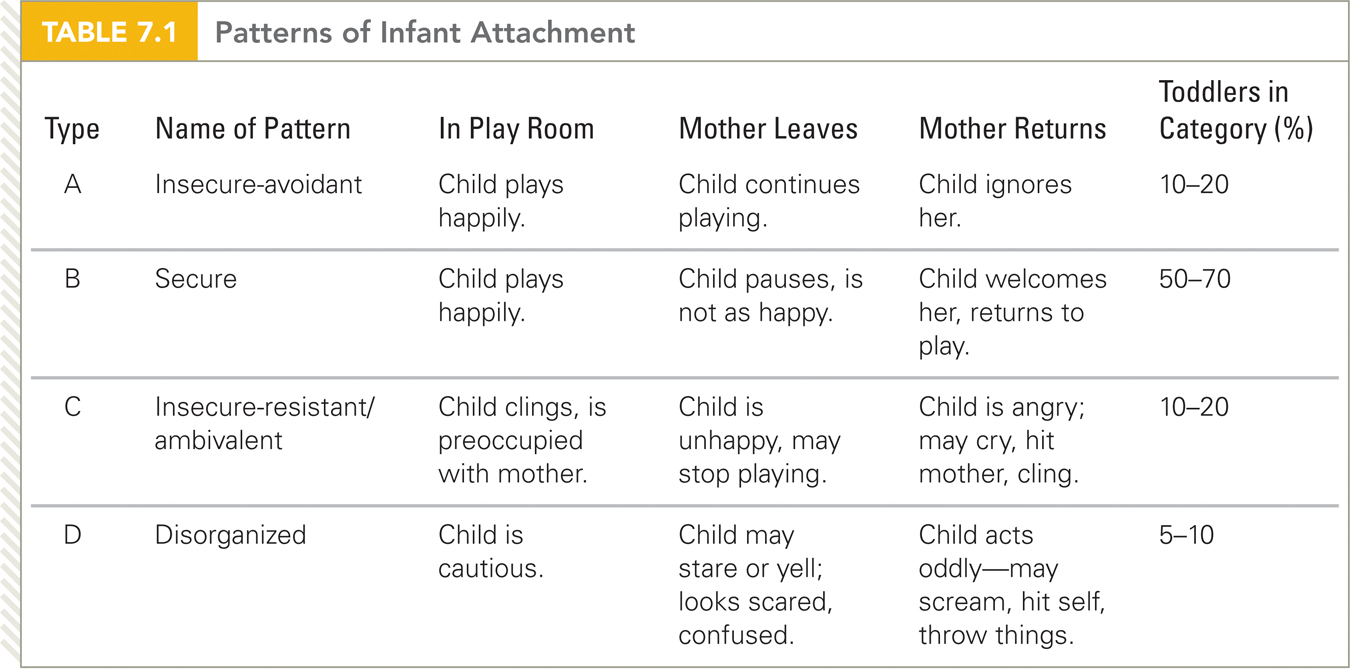
By contrast, insecure attachment (types A and C) is characterized by fear, anxiety, anger, or indifference. Some insecure children play independently without maintaining contact; this is insecure-
Ainsworth’s original schema differentiated only types A, B, and C. Later researchers discovered a fourth category (type D), disorganized attachment. Type D infants may shift suddenly from hitting to kissing their mothers, from staring blankly to crying hysterically, from pinching themselves to freezing in place.
Among the general population, about two-
About one-
Measuring Attachment
Ainsworth (1973) developed a now-
Researchers are trained to distinguish types A, B, C, and D. They focus on the following:
Exploration of the toys. A secure toddler plays happily.
Reaction to the caregiver’s departure. A secure toddler notices when the caregiver leaves and shows some sign of missing him or her.
Reaction to the caregiver’s return. A secure toddler welcomes the caregiver’s reappearance, usually seeking contact, and then plays again.

Attachment is not always measured via the Strange Situation; surveys and interviews are also used. Sometimes parents answer 90 questions about their children’s characteristics, and sometimes adults are interviewed extensively (according to a detailed protocol) about their relationships with their own parents, again with various specific measurements (Fortuna & Roisman, 2008).
Research measuring attachment has revealed that some behaviors that might seem normal are, in fact, a sign of insecurity. For instance, an infant who clings to the caregiver and refuses to explore the toys might be type A. Likewise, adults who say their childhood was happy and their mother was a saint, especially if they provide few specific memories, might be insecure. And young children who are immediately friendly to strangers may never have formed a secure attachment (Tarullo et al., 2011).
Assessments of attachment that were developed and validated for middle-
Insecure Attachment and the Social Setting
At first, developmentalists expected secure attachment to “predict all the outcomes reasonably expected from a well-
Securely attached infants are more likely to become secure toddlers, socially competent preschoolers, high-
Although attachment patterns form in infancy (see Table 7.2), they are not set in stone; they may change when the family context changes, such as new abuse or income loss. Poverty increases the likelihood of insecure attachment, and insecure attachment correlates with later learning problems, but a third variable may be the reason for this correlation. For instance, many aspects of low SES increase the risk of low school achievement, hostile children, fearful adults, all also increased with insecure infant attachment.
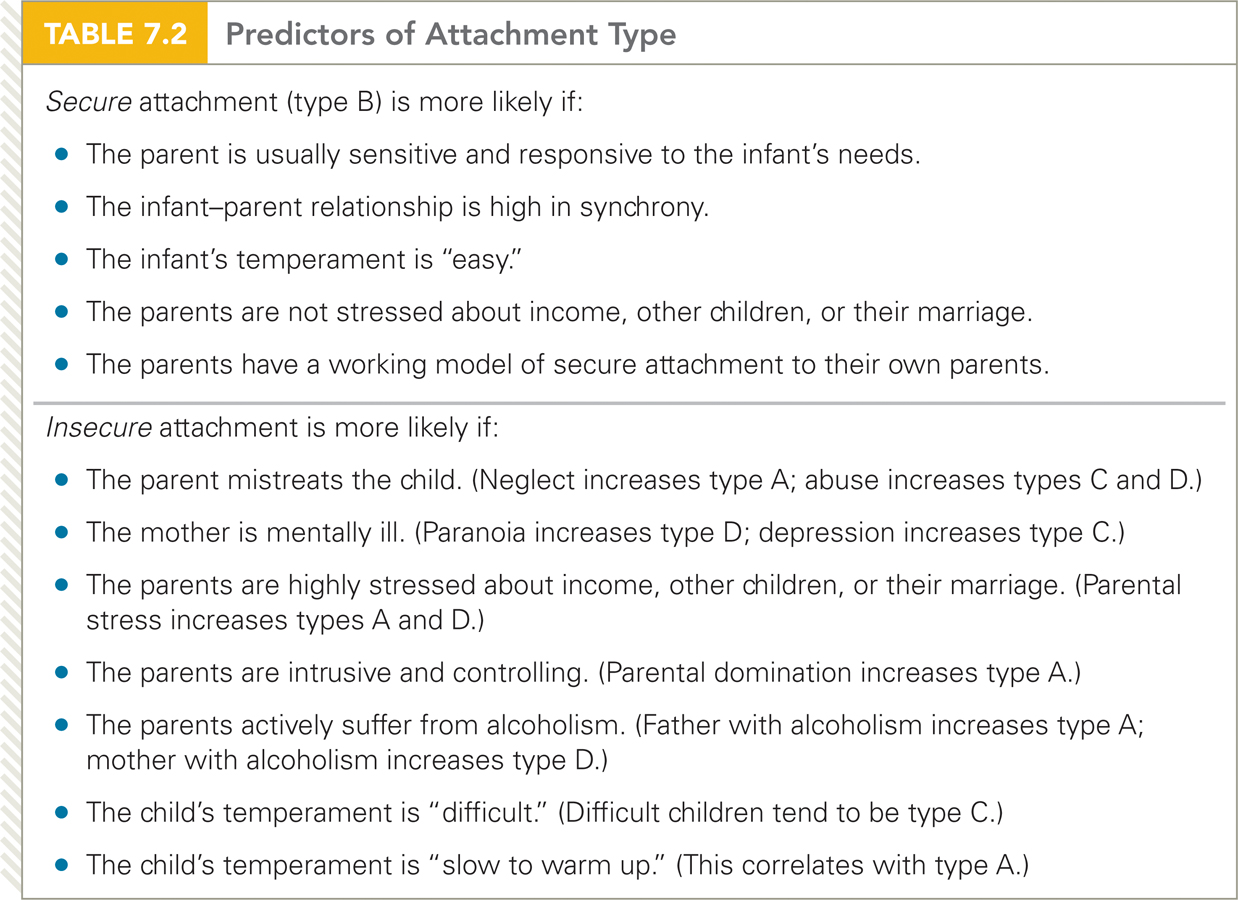
The underlying premise—
Insights from Romania
No scholar doubts that close human relationships should develop in the first year of life and that the lack of such relationships risks dire consequences. Unfortunately, thousands of children born in Romania are proof.
When Romanian dictator Nicolae Ceausesçu forbade birth control and abortions in the 1980s, illegal abortions became the leading cause of death for Romanian women aged 15 to 45 (Verona, 2003), and more than 100,000 children were abandoned to crowded, impersonal, state-
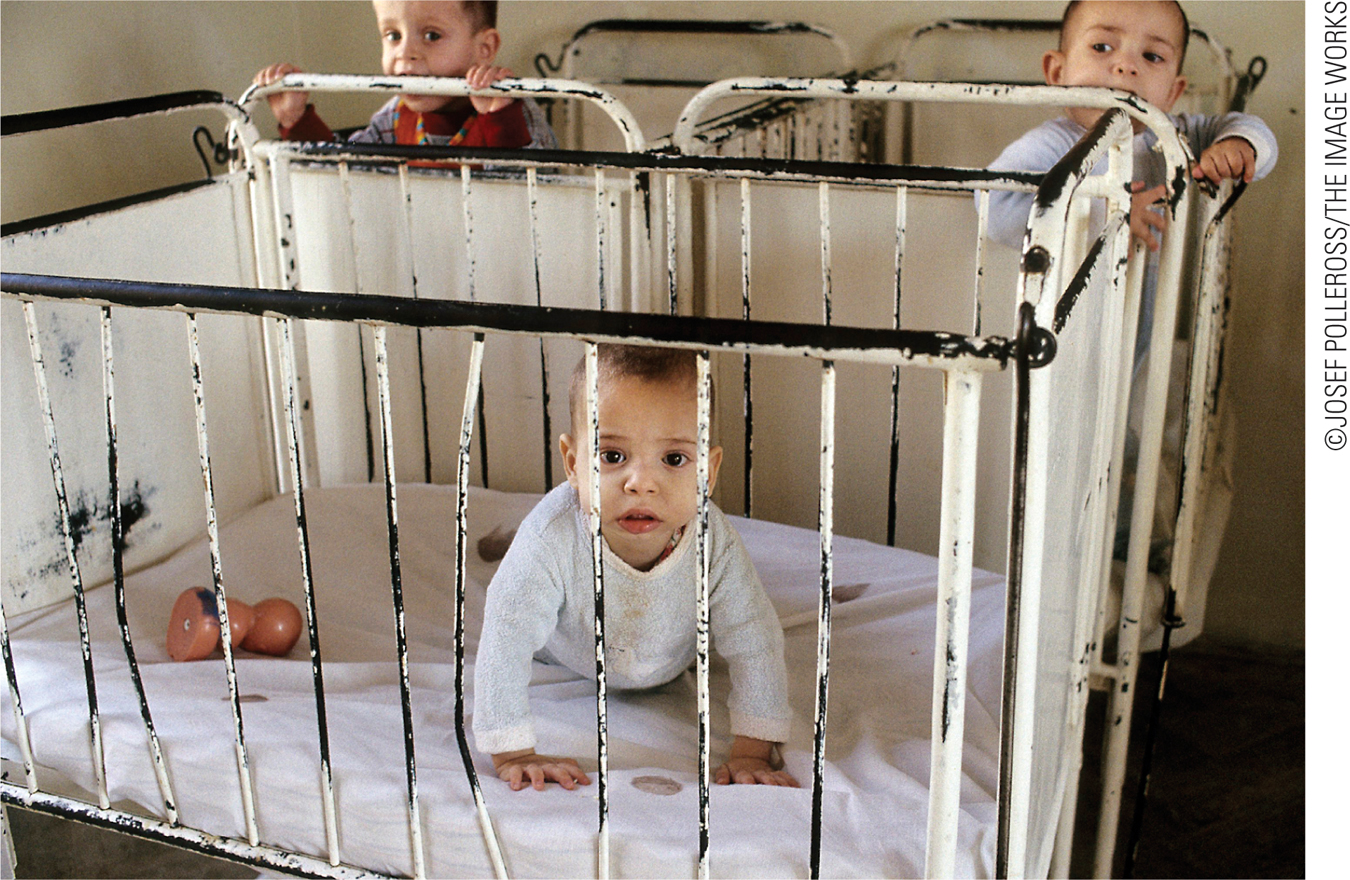
In the two years after Ceausesçu was ousted and killed in 1989, thousands of those children were adopted by North American, western European, and Australian families. Those who were adopted before 6 months of age fared best; the adoptive parents established synchrony via play and caregiving. Most of the children developed normally.
For those adopted after 6 months, and especially after 12 months, early signs were encouraging: Skinny infants gained weight and grew faster than other 1-
Even among those who were well nourished, or who caught up to normal growth, many became impulsive, angry teenagers. Apparently, the stresses of adolescence and emerging adulthood have exacerbated the cognitive and social strains on these young people and their families (Merz & McCall, 2011).
These children are now adults, many with serious emotional or conduct problems. The cause is more social than biological. Research on children adopted nationally and internationally finds that many develop into normal adults, but every stress—
Romanian infants are no longer available for international adoption, even though some remain abandoned. Research confirms that early emotional deprivation, not genes or nutrition, is their greatest problem. Romanian infants develop best in their own families, second best in foster families, and worst in institutions (Nelson et al., 2007). As best we know, this applies to infants everywhere: Families usually nurture their babies better than strangers who care for many infants at once, and the more years children spend in an impersonal institution, the more likely it is they will become socially and intellectually impaired (Julian, 2013).
Fortunately, in Eastern Europe and elsewhere, institutions have improved or been shuttered; more-
Preventing Problems
All infants need love and stimulation; all seek synchrony and then attachment—
Since synchrony and attachment develop over the first year, and since a third of all parents have difficulty establishing secure attachments, many developmentalists have sought to discover what particularly impairs these parents and what can be done to improve their parenting.
Secure attachment is more difficult to achieve when the parents were abused as children, when families are socially isolated, when mothers are young adolescents, or when infants are unusually difficult (Zeanah et al., 2011). If biological parents do not care for their newborns, foster or adoptive parents need to be found quickly so that synchrony and attachment can develop (McCall, 2013).
Some birth parents, fearing that they cannot provide responsive parenting, choose adoptive parents for their newborns. If high-
Social Referencing

Social referencing refers to seeking emotional responses or information from other people, much as a student might consult a dictionary or other reference work. Someone’s reassuring glance, cautionary words, or a facial expression of alarm, pleasure, or dismay—
Even at 8 months, infants notice where other people are looking and use that information to look in the same direction themselves (Tummeltshammer et al., 2014). After age 1, when infants can walk and are “little scientists,” their need to consult others becomes urgent as well as more accurate.
Toddlers search for clues in gazes, faces, and body position, paying close attention to emotions and intentions. They focus on their familiar caregivers, but they also use relatives, other children, and even strangers to help them assess objects and events. They are remarkably selective, noticing that some strangers are reliable references and others are not (Fusaro & Harris, 2013).
Social referencing has many practical applications. Consider mealtime. Caregivers the world over smack their lips, pretend to taste, and say “yum-
Through this process, some children develop a taste for raw fish or curried goat or smelly cheese—
Fathers as Social Partners
Fathers enhance their children’s social and emotional development in many ways (Lamb, 2010). Synchrony, attachment, and social referencing are sometimes more apparent with fathers than with mothers. Furthermore, fathers typically elicit more smiles and laughter from their infants than mothers do, probably because they play more exciting games, while mothers do more caregiving and comforting (Fletcher et al., 2013).
Although gender, cultural, and age differences emerge fathers and mothers often work together to raise the children. One researcher reports “mothers and fathers showed patterns of striking similarity: they touched, looked, vocalized, rocked, and kissed their newborns equally” (Parke, 2013, p. 121). Differences are obvious from one couple to another, but not from one gender to another—
It is a stereotype that African American, Latin American, and Asian American fathers are less nurturing and more strict than other men (Parke, 2013). Within the United States, the trend toward more father–
Close father–

Less rigid gender roles seem to be developing in every nation, allowing a greater caregiving role for fathers within every nation (Lamb, 2013). One U.S. example of historical change is the number of married women with children under age 6 who are employed. In 1970, 30 percent of married mothers of young children earned paychecks; in 2012, 60 percent did (U.S. Bureau of Labor Statistics, 2013). These statistics include many mothers of infants, who often rely on the baby’s father for child care.
Note the reference to “married” mothers: About half the mothers of infants in the United States are not married, and their employment rates are higher than their married counterparts. Often, the fathers of their infants are active in child care, whether or not they cohabit. As detailed later in this chapter, fathers—
Nonetheless, in most cultures and ethnic groups, fathers of every marital status still spend less time with infants than mothers do (Parke, 2013; Tudge, 2008). National cultures and parental attitudes are influential: Some women are gatekeepers, believing that child care is their special domain. They exclude fathers (perhaps indirectly, saying, “You’re not holding her right”).
When mothers engage the fathers in child care, they must not imply that he cannot do it properly. For example, she may lay out the clothes the baby is to wear, as if he could not find clothes (Pedersen & Kilzer, 2014). Both parents, ideally, are infant caregivers.
One male/female difference seems to persist: When asked to play with their baby, mothers typically caress, read, sing, or play traditional games such as peek-
Over the past 20 years, father–
Can men provide the same care as women?
Is father–
infant interaction different from mother– infant interaction? How do fathers and mothers cooperate to provide infant care?
Many studies over the past two decades have answered yes to the first two questions. A baby fed, bathed, and diapered by Dad is just as happy and clean as when Mom does it. Gender differences are sometimes found in specifics, but they are not harmful.
On the third question, the answer depends on the family (Bretherton, 2010). Usually, mothers are caregivers and fathers are playmates, but not always. Each couple, given their circumstances (which might include being immigrant, low-
A constructive parental alliance can take many forms, but it cannot be taken for granted, no matter what the family configuration. Single-
Sometimes no one is happy with the infant, and then the baby suffers. Father care can be quite wonderful, but it is not always so. One study reported that 7 percent of fathers of 1-
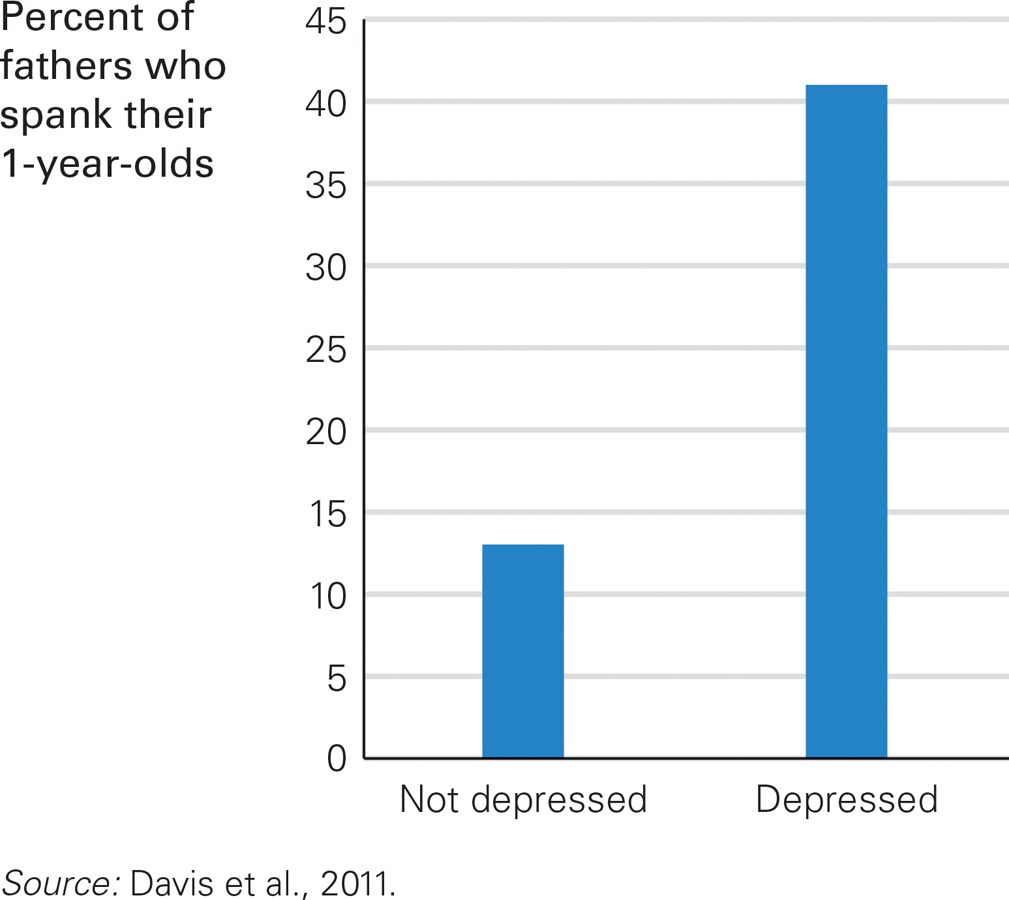
Shame on Who? Not on the toddlers, who are naturally curious and careless, but maybe not on the fathers, either. Both depression and spanking are affected by financial stress, marital conflict, and cultural norms; who is responsible for those?
Family members affect each other. Paternal depression correlates with maternal depression and with sad, angry, disobedient toddlers. Cause and consequence are intertwined. When anyone is depressed or hostile, everyone (mother, father, baby, sibling) needs help.
SUMMING UP Caregivers and young infants engage in split-
Toddlers use other people as social references to guide them in their exploration. Fathers are as capable as mothers in social partnerships with infants, although they may favor physical, creative play more than mothers do. Every family member affects all the others; ideally, they cooperate to create a caregivers’ alliance to support the baby’s development.
WHAT HAVE YOU LEARNED?
Question 7.11
How might synchrony affect early emotional development?
Parental responsiveness during synchrony aids psychosocial and biological development by providing powerful learning experiences. In every episode, infants learn to read another's facial expression, body language, and emotions, thereby laying the foundation for the development of social skills.Question 7.12
How might an infant demonstrate proximity-
seeking and contact- maintaining attachment? Infants show their attachment through proximity–seeking (such as approaching and following their caregivers) and through contact– maintaining (such as touching, snuggling, and holding). Those attachment expressions are evident when a baby cries if the caregiver closes the door when going to the bathroom or fusses if a back– facing car seat prevents the baby from seeing the parent. To maintain contact when driving in a car and to reassure the baby, some caregivers in the front seat reach back to give a hand, or install a mirror so they can see the baby and the baby can see them as they drive. Some caregivers take the baby into the bathroom. As in this example, maintaining contact need not be physical: Visual or verbal connections are often sufficient. Question 7.13
How might each of the four types of attachment be expressed in adulthood?
Securely attached: Later in life, they tend to have good relationships and good self–esteem.
Avoidant: Later in life, they tend to be aloof in personal relationships.
Resistant/Ambivalent: Later in life, their relationships may be angry, stormy, and unpredictable.
Disorganized: Later in life, they can demonstrate odd behavior—including sudden emotions. Question 7.14
What has been learned from the research on Romanian infants?
Thousands of children born in Romania are proof that the lack of close human relationships risks dire consequences. When Romanian dictator Nicolae Ceausesçu forbade birth control and abortions in the 1980s, more than 100,000 children were abandoned to crowded, impersonal, state–run orphanages. The children experienced severe deprivation, including virtually no normal interaction, play, or conversation. Thousands of those children were adopted by North American, Western European, and Australian families. Those who were adopted before 6 months of age fared best; the adoptive parents established synchrony via play and caregiving. Most of the children developed normally. For those adopted after 6 months and especially after 12 months, early signs were encouraging: Skinny infants gained weight and grew faster than other 1– year– olds, developing motor skills they had lacked. However, their early social deprivation soon became evident in their emotions and intellect. Many were overly friendly to strangers throughout childhood, a sign of insecure attachment. At age 11, their average IQ was only 85, 15 points below normal. These children are now adults, many with serious emotional or conduct problems. The cause is more social than biological. Question 7.15
How is social referencing important in toddlerhood?
Toddlers use social referencing for clues in the faces and body position of trusted others, paying close attention to emotions and intentions in order to learn how to interpret the world. If the trusted other looks calm then the child knows the situation is not dangerous.Question 7.16
How do fathers contribute to infant development?
Fathers enhance their children's social and emotional development in many ways, and synchrony, attachment, and social referencing are all apparent with fathers. Close father–infant relationships can teach infants appropriate expressions of emotion, particularly anger. Fathers also elicit more smiles and laughter from infants than mothers do, engaging more often in exciting and active play.